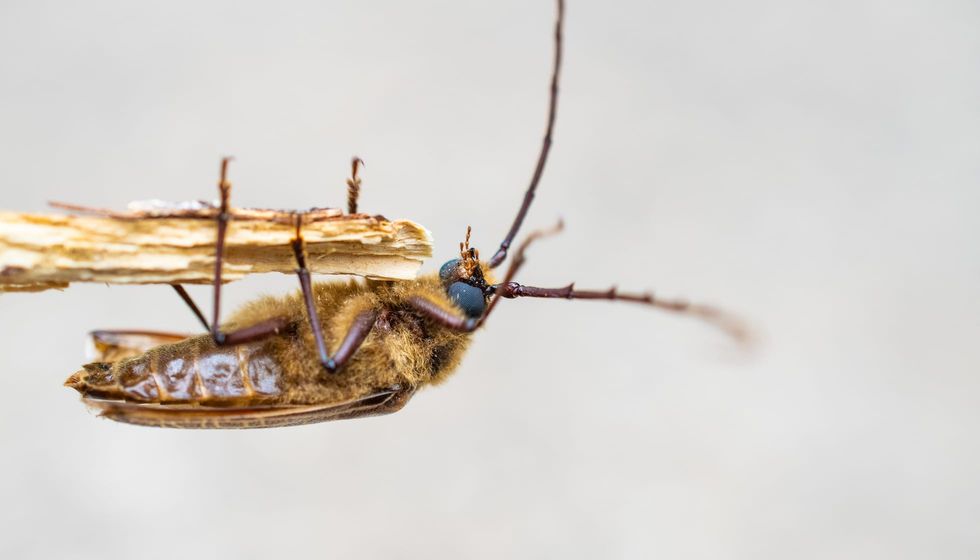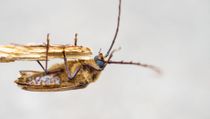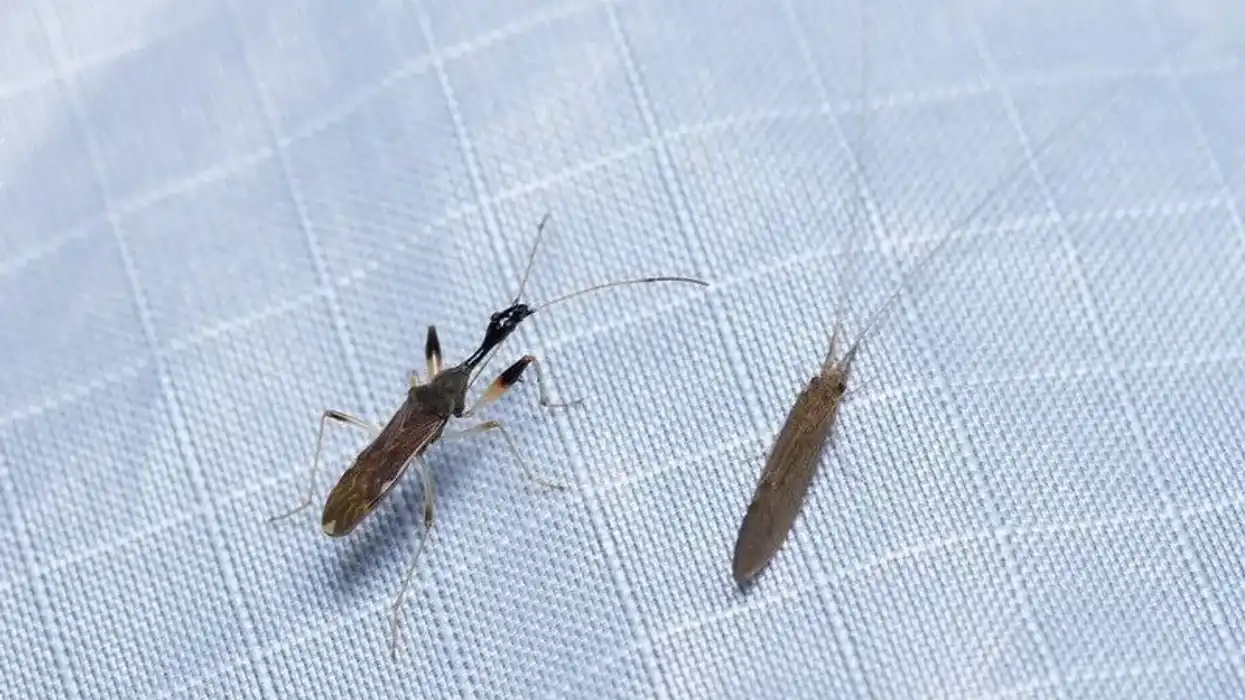The huhu beetle (Prionoplus reticularis) is the largest beetle endemic to New Zealand. There are several huhu beetle names in the native Maori language, the larva being referred to as huhu, and the adults are called Pepe-te-muimui.
These beetles inhabit the Podocarp forests and are known to infest timber, dead wood, and logs in the forest. Adult huhu beetles are attracted to well-lit rooms and outdoors and often terrorize people with their menacing appearance.
A female huhu lays about clusters of white 10-50 eggs inside a wood chamber or hole. These eggs are cigar-shaped and hatch after three to four weeks.
After this, the larval stage begins with metamorphosis that can extend for more than a year or two. The adult huhu beetle is known to survive for only two weeks.
Huhu grubs are a popular food choice among the native people of New Zealand, and the larval stage is either cooked or eaten raw. Although adult huhu beetles look menacing, they are actually not aggressive if not provoked.
If you liked reading this article, then do check out the American oil beetle and longhorn beetle.
Huhu Beetle Interesting Facts
What type of animal is a huhu beetle?
New Zealand's huhu beetle is an insect that belongs to the Cerambycidae family.
What class of animal does a huhu beetle belong to?
The huhu beetle belongs to the class Insecta or Arthropoda, just like the oriental cockroach and wrap-around spider.
How many huhu beetles are there in the world?
Though the exact number of huhu beetles in the world is not known, they are related to longhorn beetles that total more than 35,000 species in the world.
Where does a huhu beetle live?
The huhu beetle (Prionoplus reticularis) is endemic to New Zealand, and is the largest and heaviest beetle found in this country.
What is a huhu beetle's habitat?
The huhu grub inhabits the Podocarp forest, timber, and deadwood. Apart from these places, they are also seen to reside in exotic softwood, and semi decayed hardwoods of Acacia, Nothofagus, and Eucalyptus. The softwood of Pinus radiata is their first choice of host tree.
Who do huhu beetles live with?
The huhu beetle family is seen to live together and feed on wood logs and timber. They are also spotted together in colonies in well-lit rooms.
How long does a huhu beetles live?
The adult beetle has a very short lifespan and lives only for about two weeks. The cylindrical white larvae are known to live for more than two years, while the pupal stage sustains for about 25 days.
How do they reproduce?
Adult grubs reproduce by laying large clusters of eggs, ranging from 10-50. Often a cluster of 100 eggs is also found in the wood chamber.
These eggs are mostly found in crevices of timber holes or under tree bark. The white-colored cigar-shaped egg is about 0.1 in (0.25 cm) that hatches after three to four weeks.
The larvae continue to develop in timber and deadwood before the pupal stage begins. The lifespan of the larvae is more than two years and they begin to metamorphose into the pupal cell from beneath the bark. This pupation continues for up to a period of 25 days, after which the adult emerges out.
This takes place during the months of November to March. The adults do not feed and survive for only two weeks, unlike the adult Asian long-horned beetle that is known to survive for about 50-66 days.
What is their conservation status?
The conservation status of New Zealand's huhu beetle is Not Evaluated in the IUCN Red List.
Huhu Beetle Fun Facts
What do huhu beetles look like?
The huhu grub bears a black and brown body. The head has a pair of long antennae.
They possess spines at the end of each antennal segment that is longer in males than in females. Like other insects, the body of the huhu grub is divided into head, thorax, and abdomen, along with a chitinous exoskeleton. These insects have robust triangular jaws, and their thorax consists of a patch of brown hair.
How cute are they?
The huhu grub of New Zealand is not considered cute at all due to its intimidating black and brown body with extremely long antennae.
How do they communicate?
These beetles are known to communicate by secreting chemical substances called pheromones. They also mark their presence by producing loud buzzing sounds when in colonies.
How big is a huhu beetle?
Adult huhu grubs are about 1.9-2.9 in (4.82-7.36 cm) and are way bigger than the green scarab beetle that is only about 0.31 in (0.8 cm).
How fast can huhu beetles move?
Though the exact speed of this insect is not recorded yet, it is known that the species of longhorn beetles belonging to the Cerambycidae family as well is not able to move very fast but usually flies for short distances in the forest.
How much does a huhu beetle weigh?
The exact weight of the huhu beetle is not known, but beetles belonging to the same Cerambycidae family weigh about 0.017-0.024 oz (0.48-0.38 g).
What are the male and female names of the species?
No specific names are given to the male and female insects of this species.
What would you call a baby huhu beetle?
A baby beetle is called a larva after it hatches out of its egg.
What do they eat?
The huhu grub of New Zealand is known to feed on wood and timber. They also eat the soft exotic wood of Pinus radiate and the decayed wood of Acacia, Nothofagus, and Eucalyptus trees. Only the larvae are known to eat wood, while the adults do not eat wood.
Are they harmful?
Though they look intimidating due to their body size and appearance, they are not harmful to humans if not provoked or threatened. The huhu beetle bite is known to inflict excruciating pain.
Would they make a good pet?
Huhu grubs reside mostly in the forest and feed on wood. The adults look menacing and are not kept as pets. The larvae are eaten by humans and other mammals. Birds and other bigger insects are known to feed on the adult huhu beetles.
Did you know...
Adult huhu females are capable of producing an olfactory or a sensory cue to attract the males for breeding. Both adults display a variety of acts if disturbed during mating.
These acts include the raising of their head, opening of their mandibles to their full extent, and the head moving forwards.
They often engage themselves in dwells with another huhu individual in which they showcase several combat techniques, using their forelegs and robust mandibles. Their combat usually comes to an end with the loss of appendages and the beetle being thrown upside down.
Do huhu beetles bite?
If provoked or threatened, these beetles bite and cause tremendous pain. Otherwise, they are not aggressive in nature.
Huhu grubs
Huhu grubs or larvae metamorphose into adult beetles with a distinct head, thorax, and abdomen. The legs of adults are better developed than in the larvae.
The grubs are eaten by humans, and their taste is similar to that of buttery chicken or peanut butter. These are considered to be a rich source of fat to the people of New Zealand.
Here at Kidadl, we have carefully created lots of interesting family-friendly animal facts for everyone to discover! Learn more about some other arthropods from our eastern Hercules beetle facts and stag beetle facts pages.
You can even occupy yourself at home by coloring in one of our free printable beetle coloring pages.
Second image by Neil William Birrell









